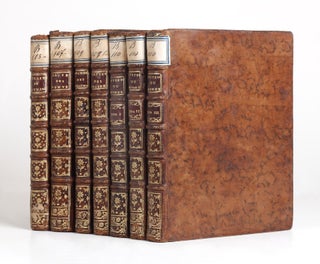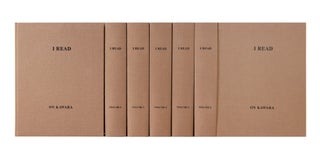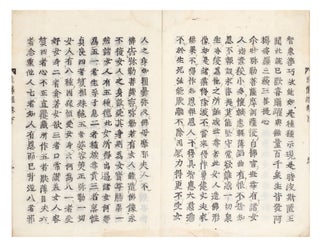A Rare Commentary on One of the Most Influential Treatises
in All of East Asian Buddhism;
Printed on Mt. Koya
Shaku Makaenron sho 釈摩訶衍論鈔 [A Collection of Commentaries to the Treatise on the Awakening of Faith According to the Mahayana].
More than 2150 folding leaves. 45 vols. 8vo, orig. wrappers, block-printed title labels on upper covers, new stitching. From the final two pages of the final volume (in trans. & in a different order): “Mt. Koya: printed at the Kongobuji Temple, the owner of the woodblocks is the Kangakuin Temple, & Yamamoto Heiroku is the general manager of the Eineibo, early spring 1657.”
A very rare and massive Shingon text in 45 volumes with more than 2150 folding leaves, privately printed at the Kongobuji Temple on Mt. Koya. This is an example of a Buddhist work that was not commercially marketable, putting in company with scholarly texts or huge compilations of the full canon. Such works were therefore privately printed at temples (see Kornicki, The Book in Japan, pp. 152-53). Printing of Shingon texts on Mt. Koya began in the 13th century, and the printing program of these texts on the mountain remained active into the 19th century.
Yukai (or Shogen, 1345-1416), was a scholar-monk who lived on Mt. Koya. He studied Esoteric Buddhism under Shinko at the Hosho-in Temple, of which he became head in 1374. There, he established a school called Homon. Yukai is most notable for his criticism of breakaway sects of Esoteric Shingon Buddhism, especially the Tachikawa School, which believed that by incorporating sexual rites combined with “black magic,” its practitioners could achieve enlightenment.
This work is Yukai’s extensive commentary on the Dasheng qi xin lun (Treatise on the Awakening of Faith According to the Mahayana), at one time attributed to Nagarjuna, the founder of the Madhyamaka school of Mahayana Buddhist philosophy. Later, its authorship was credited to the Indian author Asvaghosa, but it is now widely assumed to be an indigenous Chinese text, composed in the 6th century. “Since its composition, the text has remained one of the most influential treatises in all of East Asian Buddhism…The author of the Dasheng qixin lun sought to reconcile two of the dominant, if seemingly incompatible, strands in Mahayan Buddhism: Tathagatagargbha (embryo or womb of the buddhas) thought and the Alayavijinana (storehouse consciousness) theory of consciousness.”–Buswell & Lopez, The Princeton Dictionary of Buddhism, p. 221.
Heiroku Yamamoto was the manager of the printing and publishing activities for five or six temples on Mt. Koya.
In fine and fresh condition. The upper wrapper of Vol. I is a little worn and soiled. Some minor worming in most volumes. One or two of the volumes have somewhat more worming, but nowhere is it serious.
Price: $6,500.00
Item ID: 7553

![Item ID: 7553 Shaku Makaenron sho 釈摩訶衍論鈔 [A Collection of Commentaries to the Treatise on the Awakening of Faith According to the Mahayana]. YUKAI 宥快.](https://jonathanahill.cdn.bibliopolis.com/pictures/7553.jpg?width=768&height=1000&fit=bounds&auto=webp&v=1614873740)
![Shaku Makaenron sho 釈摩訶衍論鈔 [A Collection of Commentaries to the Treatise on the Awakening of Faith According to the Mahayana].](https://jonathanahill.cdn.bibliopolis.com/pictures/7553_2.jpg?width=320&height=427&fit=bounds&auto=webp&v=1614873740)
![Setsuyō ryōri taizen 節用料理大全 [or]. Shijo 高嶋吉井 TAKASHIMA.](https://jonathanahill.cdn.bibliopolis.com/pictures/6854.jpg?width=320&height=427&fit=bounds&auto=webp&v=1590847772)


